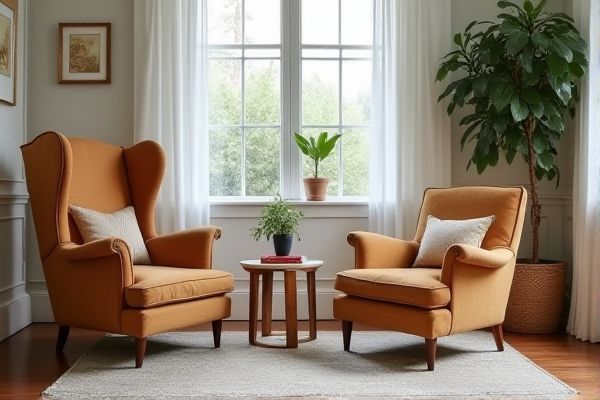
Wingback chairs feature high backs and side "wings" designed to provide extra support and create a cozy, enclosed seating experience, making them ideal for enhancing room aesthetics and comfort. Slipper chairs are armless, low-profile seats perfect for smaller spaces or as accent pieces; discover which chair best fits Your style and space by reading the rest of the article.
Table of Comparison
| Feature | Wingback Chair | Slipper Chair |
|---|---|---|
| Design | High back with winged sides for head and neck support | Low back with no arms, minimalist and compact |
| Comfort | Provides strong lumbar and upper-back support | Offers moderate comfort, ideal for casual seating |
| Use | Perfect for reading nooks, living rooms, and formal seating | Best for bedrooms, small spaces, and extra seating |
| Size | Larger and more imposing, takes up more space | Smaller footprint, easy to move and fit in tight areas |
| Style | Traditional, elegant, often upholstered | Modern, simple, often armless and low profile |
| Price Range | Typically higher due to size and materials | Generally more affordable and budget-friendly |
Introduction: Wingback Chair vs Slipper Chair
Wingback chairs feature high backrests with "wings" extending from the sides, designed to provide support and shield from drafts, making them ideal for traditional or cozy living spaces. Slipper chairs are armless, low-profile seating options with shorter legs, perfect for small rooms or as accent pieces that offer unobstructed views and easy mobility. Choosing between these chairs depends on spatial requirements, desired comfort level, and overall room aesthetics.
Historical Origins and Design Evolution
Wingback chairs originated in 17th-century England, designed to shield occupants from drafts and retain heat with their distinctive "wings" flanking the high back. Slipper chairs, emerging in the early 18th century, featured a low, armless profile ideal for intimate seating in bedrooms and boudoirs. Both chair styles evolved through the centuries, adapting upholstery techniques and aesthetic trends while maintaining their core design elements.
Distinctive Features of Wingback Chairs
Wingback chairs feature high, curved side panels designed to shield from drafts and provide head support, often creating a cozy, enclosed feeling. Their tall backrests and sturdy wooden legs emphasize a traditional, elegant aesthetic perfect for classic interiors. These chairs commonly include upholstery with button tufting or intricate detailing, distinguishing them from slipper chairs, which have low backs and lack wings.
Defining Characteristics of Slipper Chairs
Slipper chairs feature a low, armless design with a wide seat and short legs, making them ideal for compact spaces and added seating without bulk. Their upholstery typically extends to the floor, creating a sleek, minimal profile that contrasts with the taller, winged back and armrests of wingback chairs. These chairs emphasize comfort and simplicity, often used in bedrooms or living rooms to complement existing furniture.
Comfort and Ergonomic Differences
Wingback chairs provide superior neck and upper back support thanks to their high, curved sides, making them ideal for relaxation and reading. Slipper chairs feature low, armless designs that offer a more open seating experience but less ergonomic support for prolonged use. Your choice depends on whether you prioritize enveloping comfort or sleek simplicity in seating.
Style and Aesthetic Appeal
Wingback chairs feature high backs with wings that provide a classic, elegant silhouette often associated with traditional or vintage decor. Slipper chairs offer a sleek, armless design that enhances the minimalist and modern aesthetic, making them ideal for smaller spaces or contemporary interiors. Your choice between these styles should reflect the desired ambiance, balancing the wingback's stately presence with the slipper chair's understated charm.
Space Requirements and Placement Ideas
Wingback chairs feature tall, winged sides that require more vertical and horizontal space, making them ideal for larger rooms or corners where they can act as a statement piece. Slipper chairs have a lower profile and compact design, fitting easily into smaller spaces like bedrooms, offices, or under windows. Placement of wingback chairs works well alongside fireplaces or reading nooks, while slipper chairs are perfect for adding extra seating without overwhelming the room.
Versatility in Home Décor
Wingback chairs offer timeless elegance and a structured silhouette, making them ideal for adding a classic touch to living rooms or reading nooks. Slipper chairs, with their low profile and armless design, provide versatile seating options that easily fit into smaller spaces or contemporary interiors. Your choice between the two depends on whether you want a statement piece or a subtle, adaptable chair to complement various home decor styles.
Price Range and Material Options
Wingback chairs generally have a higher price range, starting around $500 and going up to $2,000 or more due to their complex frame and traditional craftsmanship. Slipper chairs are more affordable, typically ranging from $150 to $600, often featuring simpler designs and lighter materials like wood or metal frames. Your choice depends on budget constraints and preferred upholstery options, as wingback chairs commonly use leather or heavy fabric, while slipper chairs offer more variety in fabric and synthetic materials.
How to Choose: Wingback or Slipper Chair?
Choose a wingback chair to create a classic, cozy ambiance with its high-backed design providing extra head and neck support, ideal for reading nooks or traditional living rooms. Opt for a slipper chair when space-saving and sleek, low-profile seating with no arms is desired, making it perfect for small rooms or modern decor. Evaluate room size, style preference, and functional needs to decide between the stately wingback or the minimalist slipper chair.
 homyna.com
homyna.com